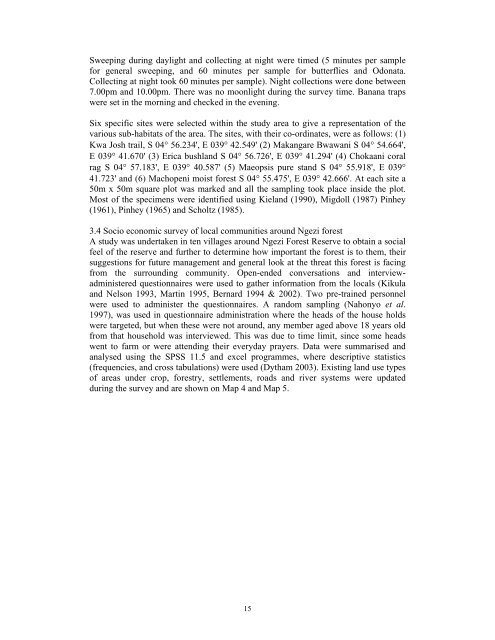serikali ya mapinduzi zanzibar care tanzania and department
serikali ya mapinduzi zanzibar care tanzania and department
serikali ya mapinduzi zanzibar care tanzania and department
Create successful ePaper yourself
Turn your PDF publications into a flip-book with our unique Google optimized e-Paper software.
Sweeping during daylight <strong>and</strong> collecting at night were timed (5 minutes per sample<br />
for general sweeping, <strong>and</strong> 60 minutes per sample for butterflies <strong>and</strong> Odonata.<br />
Collecting at night took 60 minutes per sample). Night collections were done between<br />
7.00pm <strong>and</strong> 10.00pm. There was no moonlight during the survey time. Banana traps<br />
were set in the morning <strong>and</strong> checked in the evening.<br />
Six specific sites were selected within the study area to give a representation of the<br />
various sub-habitats of the area. The sites, with their co-ordinates, were as follows: (1)<br />
Kwa Josh trail, S 04° 56.234', E 039° 42.549' (2) Makangare Bwawani S 04° 54.664',<br />
E 039° 41.670' (3) Erica bushl<strong>and</strong> S 04° 56.726', E 039° 41.294' (4) Chokaani coral<br />
rag S 04° 57.183', E 039° 40.587' (5) Maeopsis pure st<strong>and</strong> S 04° 55.918', E 039°<br />
41.723' <strong>and</strong> (6) Machopeni moist forest S 04° 55.475', E 039° 42.666'. At each site a<br />
50m x 50m square plot was marked <strong>and</strong> all the sampling took place inside the plot.<br />
Most of the specimens were identified using Kiel<strong>and</strong> (1990), Migdoll (1987) Pinhey<br />
(1961), Pinhey (1965) <strong>and</strong> Scholtz (1985).<br />
3.4 Socio economic survey of local communities around Ngezi forest<br />
A study was undertaken in ten villages around Ngezi Forest Reserve to obtain a social<br />
feel of the reserve <strong>and</strong> further to determine how important the forest is to them, their<br />
suggestions for future management <strong>and</strong> general look at the threat this forest is facing<br />
from the surrounding community. Open-ended conversations <strong>and</strong> interviewadministered<br />
questionnaires were used to gather information from the locals (Kikula<br />
<strong>and</strong> Nelson 1993, Martin 1995, Bernard 1994 & 2002). Two pre-trained personnel<br />
were used to administer the questionnaires. A r<strong>and</strong>om sampling (Nahonyo et al.<br />
1997), was used in questionnaire administration where the heads of the house holds<br />
were targeted, but when these were not around, any member aged above 18 years old<br />
from that household was interviewed. This was due to time limit, since some heads<br />
went to farm or were attending their everyday prayers. Data were summarised <strong>and</strong><br />
analysed using the SPSS 11.5 <strong>and</strong> excel programmes, where descriptive statistics<br />
(frequencies, <strong>and</strong> cross tabulations) were used (Dytham 2003). Existing l<strong>and</strong> use types<br />
of areas under crop, forestry, settlements, roads <strong>and</strong> river systems were updated<br />
during the survey <strong>and</strong> are shown on Map 4 <strong>and</strong> Map 5.<br />
15

















